Small sweat bees are a large genus of bees (
Lasioglossum) that are active throughout the growing season. Many species in this genus are very small and often go unnoticed while they are visiting flowers. Like sweat bees, small sweat bees will also land on your skin on a hot summer day to feed on your sweat. Be sure to look before you swat, because these gentle, tiny bees may tickle you with their tongues but have no interest in stinging.
There are a few specialists in this bee genus, but the vast majority are generalist and will visit a wide variety of flowering plants. By providing something in flower throughout the growing season, you can attract a variety of small sweat bees to your garden.
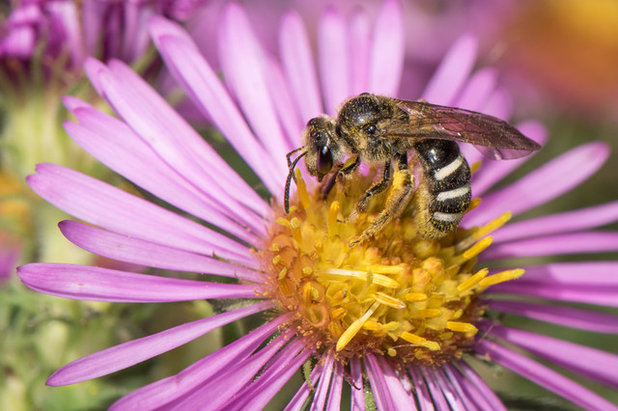
Holm Design & Consulting LLC
A female small sweat bee (Lasioglossum sp.) perches on an aster. This is one of the larger species, with dominant basal abdominal stripes.
Family: Halictidae
Subfamily: Halictinae
Genus: LasioglossumNumbers: Approximately 290 species and five subgenera in North America (north of Mexico); 126 species east of the Mississippi; 1,760 species worldwide
Distribution: Small sweat bees are found throughout the world on every continent except Antarctica
Habitat: Woodlands, woodland edges, gardens, meadows, prairies, old fields, farms and urban, suburban and rural areas
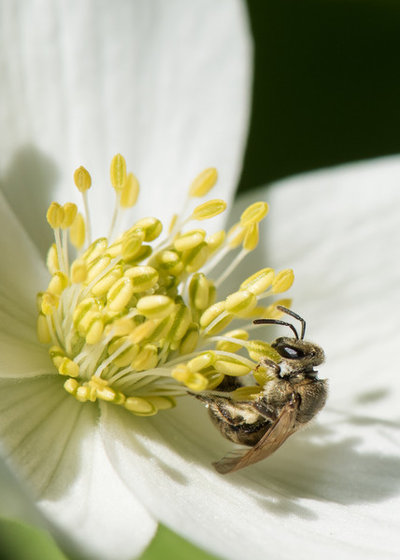
Holm Design & Consulting LLC
A female small sweat bee visits Canada anemone (Anemone canadensis) in late spring.
When to look for them: In the northern United States, early April is often when some of the first sightings of female
Lasioglossum occur; they happen earlier in the spring farther south. There are two known specialist (oligolectic) species in the mid-Atlantic and Northeast regions.
L. oenotherae is an evening primrose (
Oenothera spp.) specialist, and
L. pectinatum is a ground cherry (
Physalis spp.) specialist.
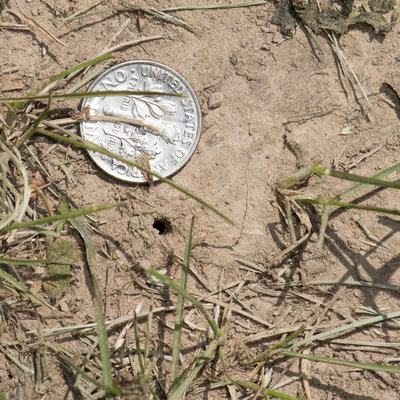
Holm Design & Consulting LLC
The entrance to a small sweat bee nest in silt-loam soil on a blueberry farm in MinnesotaHow They HelpSmall sweat bees are a diverse genus of bees, and because of their small size and long foraging season, they will visit any flower they can physically access. While perhaps not the primary pollinator of some flowering plants, they do play a role in moving pollen from flower to flower.
Like all bees, small sweat bees need a continuous succession of flowers in the garden and a variety of flower forms and colors. Females expend a lot of energy during nest-building and provisioning, and thus require an ongoing supply of pollen and nectar to fuel their activities, as well as to provide food for their offspring.
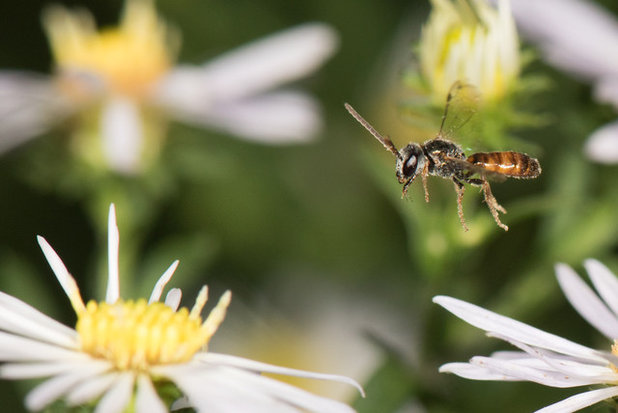
Holm Design & Consulting LLC
A male small sweat bee flies between two aster flowers. Note the long, thick antennae.How to Spot Small Sweat BeesAdults: These small bees often go unnoticed due to their size, which varies. The smaller species are approximately 1/16 inch (2 millimeters) long, and the largest are ½ inch (12 millimeters) long.
Lasioglossum are a diverse genus of small bees that are slender, dark brown, gray, black or metallic, with pale hair bands at the base of each abdominal segment. Some species have orange or red abdomens.
Males have longer, thicker antennae than females and narrower legs (lacking pollen-collecting hairs). Males are commonly seen in late summer through autumn.
Babies (larvae): Larvae are grub-like and are pale yellow to cream in color. It’s uncommon to see larvae, as small sweat bees either nest below ground or in holes in wood.
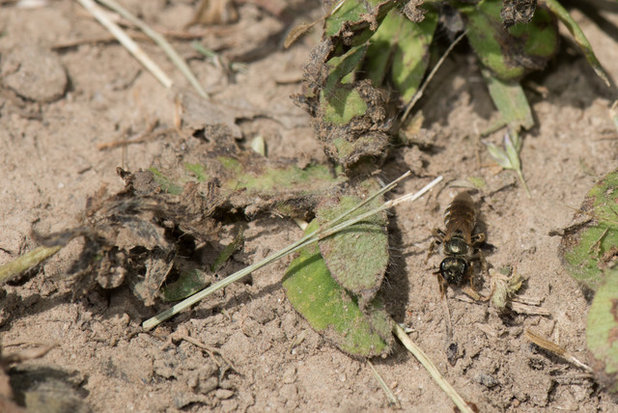
Holm Design & Consulting LLC
A female small sweat bee perches on the ground near her nest entrance.How to Lure ThemProvide a nesting place. Besides maintaining a pesticide-free garden and continuous succession of flowering plants, you’ll need a place where small sweat bees can nest. The majority of
Lasioglossum nest in the ground, and a minority nest in holes in rotting wood. For the ground-nesting species, uncompacted, bare or partially vegetated soil is an ideal site for nest initiation and excavation by females. Nest construction typically begins in spring or early summer. For the wood-nesting species, rotting logs on the ground can provide potential nesting sites.
Nests can occur in aggregations, with many nests clustered in close proximity. Small sweat bees have either solitary or primitively social nests. It’s important to look for bees excavating nests in your landscape, especially in sites where the soil is bare, and protect the site from disturbance.
Maintain a bee-safe yard. Do not use pesticides, especially insecticides, in the garden, particularly on flowering plants.
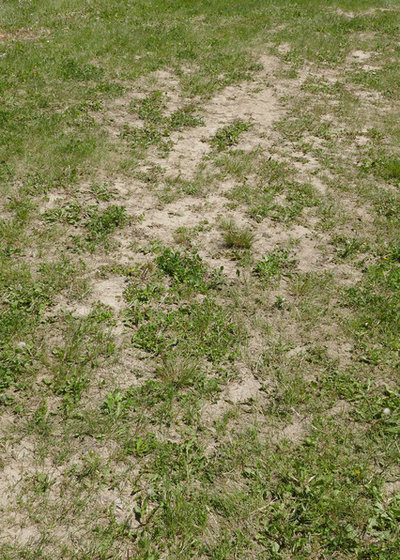
Holm Design & Consulting LLC
This site with patchy vegetation has several nests in close proximity.Offer forage plants for adults. After emerging from their overwintering site and initiating a nest in the ground, female small sweat bees begin collecting pollen and nectar in late spring and early summer. Foraging by females and, later, males continues through the summer and into the fall.
Sample plant list for adults:- Spring: Bloodroot (Sanguinaria canadensis), twoleaf miterwort (Mitella diphylla), wild geranium (Geranium maculatum), red columbine (Aquilegia canadensis), spiderwort (Tradescantia spp.) and tall meadow-rue (Thalictrum dasycarpum)
- Summer: Purple prairie clover (Dalea purpurea), yellow loosestrife (Lysimachia spp.), vervain (Verbena spp.) and nodding onion (Allium cernuum)
- Late summer and fall: Goldenrod (Solidago spp.), common boneset (Eupatorium perfoliatum) and asters (any species)
Browse plants native to your region
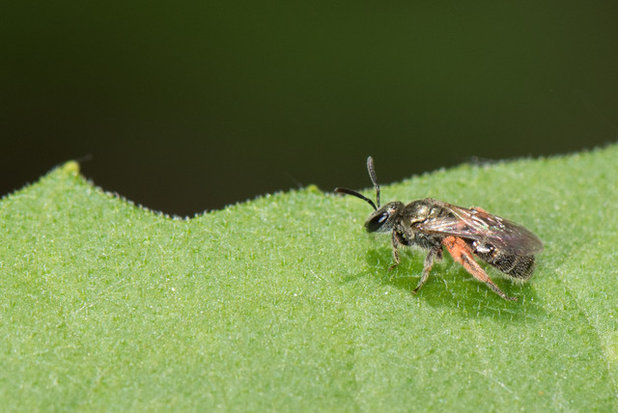
Holm Design & Consulting LLC
A female small sweat bee sits on a leaf.Life cycle. In the upper Midwest, Great Lakes and Northeast regions, small sweat bees produce one to three generations per year. Nests, whether solitary or eusocial, are established by females that have mated in the fall, overwintered, then emerged the following spring. Depending on the species, nests can occur singly or in aggregations.
For species that produce one generation per year, both male and female offspring are produced, and these bees begin to emerge from the nest in summer. The females mate with males then find a place below ground to overwinter.
For species that produce two or more generations per year, the first generation produced in the nest is comprised of approximately equal male and females. The female daughters are smaller than their mother and usually become workers (in a eusocial nest). The offspring from the second (or third) generation forage into fall. Any active females mate with males, then overwinter underground. All the males perish at the end of the season.
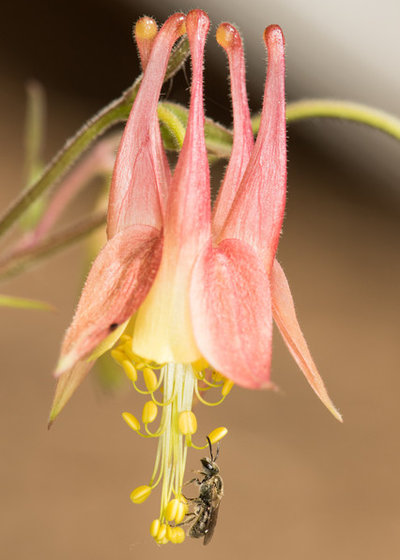
Holm Design & Consulting LLC
A female small sweat bee climbs up the anthers of red columbine (Aquilegia canadensis).Females excavate their nests by digging into the ground, forming a short tunnel. From this burrow lateral brood cells are excavated, where the female deposits pollen and nectar that she has collected from flowers. These floral resources are combined to form a pollen ball (bee bread), and when enough pollen and nectar have been collected for a given brood cell, the female lays a single egg on the provisions, then caps the cell with soil. The capped brood cell is backfilled with soil, often with soil excavated for the next brood cell within in the nest.
Region by region: What to do in your garden this month





